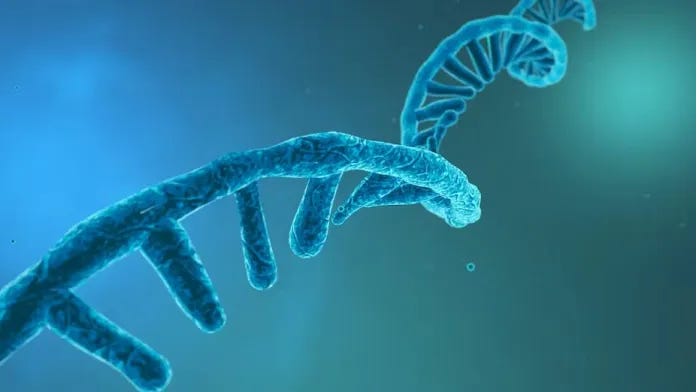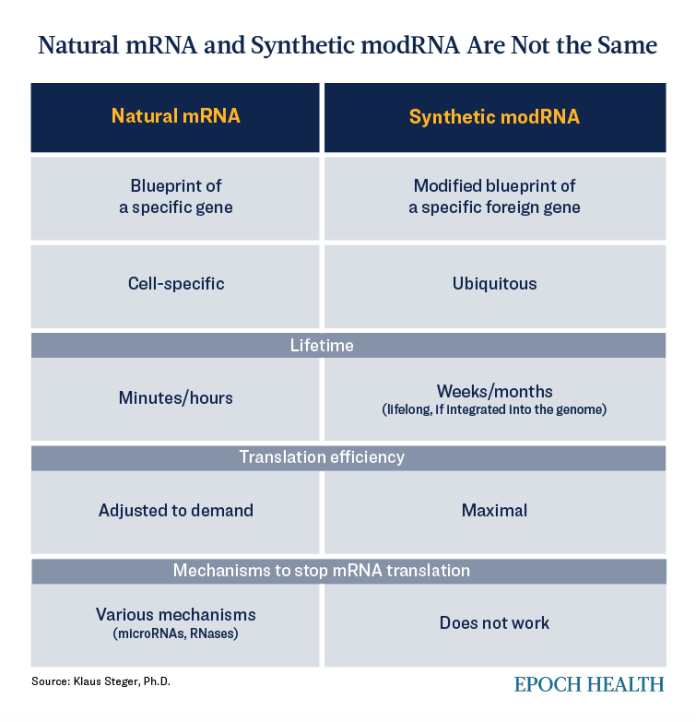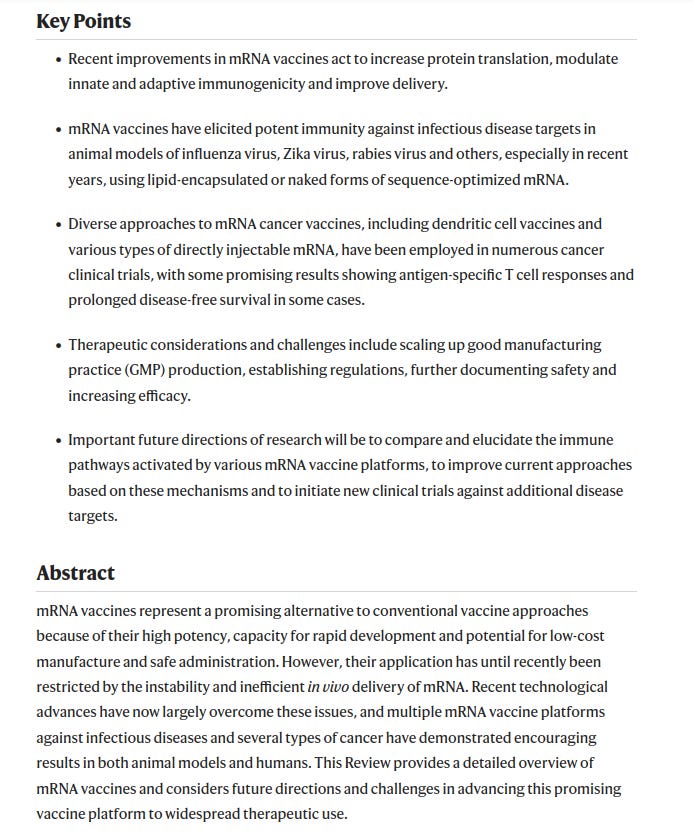COVID-19 "Vaccines" Were Never Made With mRNA
For the first time in human history, the gene regulatory program of healthy individuals has been extensively manipulated.
One-time or recurring donations can be made through Ko-Fi:
By GreatGameIndia August 1, 2023
For the first time in human history, the gene regulatory program of healthy individuals has been extensively manipulated.
Contrary to prior information, RNA-based COVID-19 injections were produced using modified RNA, not messenger RNA (mRNA).
These risks not only pertain to current COVID-19 injections and boosters but, unless we take action now, also to all future RNA-based vaccines.
mRNA and modRNA Are Distinct
mRNA is naturally occurring, residing in our cells for a short period and being relatively delicate. It represents a specific RNA type responsible for conveying instructions or “messages” from our genes, aiding in the production of proteins—the fundamental components of our cells. It is continually generated as a part of normal cellular processes, completing its function once the messages are delivered and eventually broken down in the body.
When RNA from an external source enters our cells (such as viral RNA), these cells can synthesize viral proteins.
Although we were informed that COVID-19 injections contain mRNA, a vaccine relying on “natural” mRNA would not endure long enough to trigger an immune response before being eliminated by our immune system.
To make mRNA viable for regular medical use, scientists had to artificially modify it to enhance both its efficiency and lifespan, resulting in modRNA.
modRNA has been engineered for extended viability and maximum translation. While mRNA displays a cell-specific expression pattern, modRNA can infiltrate nearly all cell types.
What brought us here?
The announcement of the discovery of mRNA in 1961 was a moment of great scientific excitement. Prior to this landmark, there had been earlier observations of this short-lived yet vital RNA intermediary, all contributing to the comprehension of how genes create mRNA and its role in protein production.
In essence, mRNA conveys genetic instructions from the cell’s DNA to ribosomes, enabling the assembly of specific proteins based on these instructions.
Shortly after the discovery, scientists delved into experiments on how to utilize mRNA to facilitate the body’s healing process. In 1990, they injected natural (unmodified) mRNA into a mouse’s skeletal muscle, resulting in the production of a protein that the mouse would not naturally produce.
However, it soon became evident that transferring natural mRNA was inefficient. While it worked in principle, it degraded rapidly and proved ineffective for therapeutic purposes.
This realization prompted the exploration of synthetic or artificially modified mRNA. Originally, this research aimed to reprogram and eliminate cancer cells—the sole focus of modRNA before the COVID-19 pandemic.
modRNA
How is RNA modified? To put it simply, one of the four compounds in RNA undergoes modification (e.g., natural nucleoside uridine is modified to create synthetic/artificial methyl-pseudouridine). The resulting modRNA possesses the following characteristics:
Increased stability (it exhibits a longer lifespan within the body).
Reduced immunogenicity (it triggers lesser stimulation of the innate immune system).
Enhanced efficiency (modRNA produces more protein compared to an equivalent amount of mRNA).
ModRNA is synthesized in a laboratory.
However, the therapeutic application of modRNA in humans brings forth challenges and risks.
Notably, modRNA contains a viral gene sequence. Once it enters a cell, modRNA commandeers the cell machinery and reprograms it to generate a viral protein, such as the spike protein.
Perhaps most astonishingly, during the development of COVID-19 vaccines and boosters, scientists were already aware that targeted delivery of modRNA was unfeasible. ModRNA cannot be selectively delivered to specific cells. As a result, it attacks perfectly healthy cells, breaching natural barriers like the blood-brain barrier.
The continuous production of an artificial viral protein depletes the cell’s energy, disrupts its metabolism, and impairs the cell’s ability to fulfill its vital functions for the entire organism.
To exacerbate matters, the immune system subsequently destroys those cells producing virus proteins.
Despite these significant drawbacks, Pfizer-BioNTech and Moderna proceeded with large-scale production of COVID-19 “vaccines” utilizing modRNA.
Natural Infection vs. modRNA Injection: How Does the Body React?
The spike protein is widely recognized as harmful to our body.
In the case of a natural infection, our immune system shields our body cells from the virus by producing specific antibodies, which may also provide cross-immunity against virus variants.
However, with the modRNA injection, our immune system cannot prevent the lipid nanoparticles from delivering modRNA into all cells, not just those with the appropriate receptor for virus binding, as seen in natural infections.
Distinguishing the Virus from the Vaccine
Some have claimed that the body’s response to the modRNA vaccine mirrors its response to the actual virus, but this is incorrect.
Let us examine the natural virus and how our body responds to it:
The virus’s RNA acts as a blueprint, containing instructions for all the components required to produce a new virus, not solely the spike protein.
The virus RNA is enveloped in a protein envelope, leading to the production of various antibodies by our immune system, which can confer some level of cross-immunity to combat virus variants.
The majority of respiratory viruses are barred from entering our body by the immune system present in the oral and nasal mucosa. The virus does not inject its RNA into blood vessels but binds to specific receptors on cell surfaces and directly injects RNA into the cells.
It is crucial to emphasize that only specific cells with the appropriate receptors on their surfaces can become infected.
Our immune system’s role is to eliminate virus-infected cells, preventing viral replication and the infection of new cells. After the battle is won (typically within a few days), our immune system ceases the process.
Now, let’s explore the body’s response to the modRNA injection (“the vaccine”):
The vaccine contains modRNA exclusively for the spike protein, resulting in no cross-immunity from vaccination.
Unlike the virus, the vaccine-modRNA lacks a protein envelope and is instead encapsulated within a lipid nanoparticle.
Lipid nanoparticles do not require receptors for cell entry; their lipid composition allows them to seamlessly merge with the cell membrane.
The immune system generates antibodies to combat antigens, including pathogens (viruses, bacteria), foreign particles (fungal spores, allergens), or any substances provoking a specific immune response. However, the lipid nanoparticles transporting modRNA lack these antigens, allowing them to evade the specific immune system’s notice and trigger nonspecific inflammation. Consequently, this dynamic leads to an upsurge in the immune system’s activity, causing an increasing production of antibodies against the spike protein. Each subsequent booster dose of lipid nanoparticles delivers a growing amount of modRNA, perpetuating the continuous production of new spike proteins.
Vaccines are administered into muscle, but direct injection into a muscle cell is nearly impossible due to the size difference between the large syringe and small cell. Often, syringes will inadvertently puncture blood vessels, causing the vaccine to be deposited in the intercellular space between muscle cells. The fluid in this intercellular space, known as lymph fluid, eventually merges with the blood due to the abundant blood supply in muscles.
The vaccine and booster modRNA will continue producing spike protein for weeks or even months, a significant departure from a natural infection, as our cell machinery (e.g., the enzyme RNase) cannot degrade artificial modRNA. Researchers have discovered that severe cases of COVID-19 were sometimes linked to immune system dysregulation (known as a “cytokine storm”) rather than the presence of the virus itself.
Poor Safety Profile of modRNA
Early preclinical studies sparked optimism regarding the benefits of RNA-based injections. However, when tested on humans, the ability to induce an immune response proved less effective than expected based on animal experiments.
A Nature review from 2018 (read below) highlighted that “recent human trials have demonstrated moderate and, in rare cases, severe injection site or systemic reactions for different mRNA platforms.”
As a result, attention shifted to modRNA.
Injected modRNA can lead to thrombosis, potentially resulting in stroke, myocardial infarction, or pulmonary embolism, and can also contribute to the formation of blood clots within blood vessels.
Analyzing open-access databases from various countries, including the United States, Europe, and the UK, reveals that these risks have materialized as real-life side effects in individuals who received COVID-19 injections.
Confidential Report on COVID-19-Related Fatalities
In June 2023, in response to a Freedom of Information Act request, previously confidential reports by BioNTech to the European Medicines Agency (EMA) were released, making some of these adverse effects public. The reports encompassed data collected over a six-month period from December 2021 to June 2022, as well as cumulative data since December 2020 (pdf).
The data disclosed 3,280 fatalities within a group of 508,351 individuals who received the vaccine during a combined period that included clinical trials and post-marketing. These deaths, along with tens of thousands of serious adverse events, occurred when vaccine manufacturers asserted that modRNA-based injections were safe.
COVID-19 Vaccines Were Never Made With mRNA
The notion of programming any cell in our body to continually produce a large quantity of a viral protein is illogical and goes against the principles of natural viral infections, leading to an excessive activation of the immune system.
Mandating gene-based modRNA injections, marketed as vaccines, for perfectly healthy individuals is both unethical and hazardous.
Read the document below:
mRNA vaccines — a new era in vaccinology
Source: greatgameindia.com
Related articles:
Dr. Michael Yeadon: Every Single Thing We Were Told Is a LIE
Dr. Michael Yeadon: My Plea to Dr. Robert Malone
Dr.Sucharit Bhakdi: "Routine Introduction of Gene-Based Vaccines Spells the Downfall of Mankind"
This Is What Total Destruction of the Immune System by mRNA Nanoparticle Bioweapon Looks Like…
Dr. Michael Yeadon: THIS MUST STOP! Pfizer Documents Show FDA Knew of Death Risk
PREMEDITATED MASS MURDER: Alarming Data From Canada and Vaccines Batch Scandal








This is a good summary. I've been using modRNA or "mRNA" (with the quotes) all along, because the disclosed active ingredient in the shots is NOT mRNA. I don't have the knowledge to write about it in any depth, but I can say that this article is thorough.
Of course now we are learning that the shots also contain variable amounts of manufacturing byproducts including plasmid DNA that has the potential to incorporate into somatic DNA if it finds itself in the right place at the right time, when a cell is dividing.
The problems with mass manufacturing were well known and unsolved when the shots were rolled out, and are still unsolved. No problem, though. Just have public health and the media repeat "safe and effective" over and over again and people will believe it, some to their dying day. This is a problem with the people, not just with the "authorities".
No one really knows what's in these shots. The disinformation is all over the place on this subject, well funded and backed up with "studies". Anyone who claims they know anything better have their OWN research to back up what they say. I'm to the point I don't trust anything I haven't seen myself. All you need to know is to not willingly be intentionally poisoned. We can all agree on that.